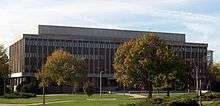John A. Hannah

John Alfred Hannah (October 9, 1902 – February 23, 1991) was president of Michigan State College (later Michigan State University) for 28 years (1941-1969), making him the longest serving of MSU's presidents. He is credited with transforming the school from a little-known, regional agricultural college into a large national research institution. After his resignation from the university, Hannah became head of the United States Agency for International Development (USAID).
Biography
A native of Grand Rapids, Hannah was most noted for expanding Michigan State from a respected regional undergraduate-oriented institution into a comprehensive national research university, and for helping to get Michigan State into the Big Ten Conference. He was also the first chairman of the United States Commission on Civil Rights.[2]
Hannah became president of Michigan State College in 1941. He thus began the largest expansion in the school's history, with the help of the 1945 G.I. Bill, which helped World War II veterans get an education. During this time the university grew by leaps and bounds to accommodate an ever-growing influx of students. One of Hannah's strategies was to build a new residence hall, enroll enough students to fill it, and use the income to start construction on a new dormitory. Under Hannah's plan, enrollment increased from 15,000 in 1950 to 38,000 in 1965.[3]

While he worked on increasing the size of M.S.C.'s student body, Hannah also expanded the institution from a college of regional reputation into a nationally-recognized research university. When the University of Chicago eliminated its athletics and resigned from what is now the Big Ten Conference in 1946, Hannah lobbied hard to take its place. The Big Ten finally admitted M.S.C. in 1950. Five years later, on the College's centennial year of 1955, the State of Michigan made it a university.[4] In 1957 he continued M.S.U.'s expansion co-founding Michigan State University–Oakland (now Oakland University) with Matilda Dodge Wilson. The Hannah Hall of Science on Oakland University's campus is named for him.[5] Michigan State University continued to expand throughout the 1960s, completing its newest dormitory in 1967. None have been built since.
By 1969, Vietnam-era protests had completely reshaped the university. Much of the controversy surrounded Hannah and the University's involvement in Vietnam with the Michigan State University Group (MSUG). Hannah was accused of being responsible for allowing the CIA to involve itself in MSUG.[6] Hannah resigned to become the head of USAID, and today these issues are generally forgotten and not brought up in discussion of Hannah. On September 17, 2004, MSU dedicated a bronze statue of Hannah in front of his namesake administration building.[7]
References
- ↑ Anderson, Kristin K. (2004-09-17). "Ceremony pays tribute to 'pragmatic visionary'". MSU Today. Retrieved 2008-03-18.
- ↑ "Civil Rights Commission report from 1960". Columbia Law Review. Retrieved 2008-03-18.
- ↑ Heineman, Kenneth J. (1993). Campus Wars: The Peace Movement at American State Universities in the Vietnam Era. New York: New York University Press. p. 21. ISBN 0-8147-3512-6.
- ↑ Kuhn, Madison. (1955). Michigan State: The First Hundred Years, 1855-1955. East Lansing: Michigan State University Press. p. 471. ISBN 0-87013-222-9.
- ↑ http://www.oakland.edu/about/buildings
- ↑
- Ernst, John (1998). Forging a Fateful Alliance: Michigan State University and the Vietnam War. East Lansing: Michigan State University Press. pp. 131–134. ISBN 0-87013-478-7.
- ↑ "Sculpture honoring former MSU President Hannah unveiled". Michigan State University Division of University Relations. Retrieved 2006-12-09.
External links
| Academic offices | ||
|---|---|---|
| Preceded by Robert S. Shaw |
President of Michigan State College of Agriculture and Applied Science 1941–1955 |
Succeeded by Himself |
| Preceded by Himself |
President of Michigan State University of Agriculture and Applied Science 1955–1964 |
Succeeded by Himself |
| Preceded by Himself |
President of Michigan State University 1964–1969 |
Succeeded by Walter Adams |
| Political offices | ||
| Preceded by Agency Founded |
Chairman of the United States Commission on Civil Rights 1958–1969 |
Succeeded by Theodore M. Hesburgh |